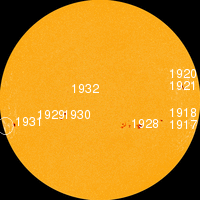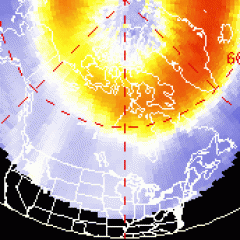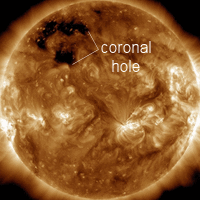ELECTRIC-BLUE CLOUDS OVER ANTARCTICA: A vast bank of electric-blue clouds has appeared over the south pole, signaling the start of the season for southern noctilucent clouds. According to data from NASA's AIM spacecraft, the clouds appeared earlier than usual this year. Researchers say this could be a sign of climate change: full story.
M-CLASS SOLAR FLARE: For more than two weeks, solar activity has been low. Hours ago, a new sunspot broke the quiet with an M3.5-class solar flare. NASA's Solar Dynamics Observatory recorded the extreme ultraviolet flash at 23:16 UT on Dec. 19th:
Radiation from the flare produced a brief wave of ionization in the upper atmosphere over the Pacific side of Earth. Otherwise, the blast was not particularly geoeffective. It did not produce an Earth-directed CME.
The instigating sunspot is still emerging over the sun's southeastern limb. Without a top-down view of the sunspot's magnetic field, it is difficult to assess the region's flare-producing potential. NOAA forecasters are guesstimating a 30% chance of more M-class flares on Dec. 20th. Solar flare alerts: text, voice
Realtime Space Weather Photo Gallery
SOLSTICES IN A BEER CAN: The northern winter solstice is only one day away. In the Netherlands that means it's time to open up a beer can and look inside. Every six months, Jan Koeman of Zierikzee, the Netherlands, deploys a beer-can solargraph to record the progress of seasons, solstice to solstice. On Dec. 18th he cracked his open and this is what he saw:
"I made a solargraph using an empty beer tin with a pinhole and photographic paper inside," explains Koeman. "The exposure time is 6 months!"
The highest arcs were traced by the summer sun ofJune 2013. The lowest arc was made by the sun on Dec. 18th, just three days before the 2013 winter solstice. Occasional gaps are caused by clouds.
"This year I placed my solargraph high and safe on an old Dutch windmill," continues Koeman. "The miller is always busy and we have a lot of wind here, so the spinning wings of the mill are barely visible in the photo."
Readers: Northern winter begins on Dec. 21st at 17:11 UT. Now is the perfect time to deploy your own beer-can solargraph for the next six months. Too young to drink? Soda cans work, too. 6-month Solargraph How-to Guides: #1, #2, #3

Solar wind
speed: 359.0 km/sec
density: 2.5 protons/cm3
explanation | more data
Updated: Today at 1616 UT
X-ray Solar Flares
6-hr max: M1 1157 UT Dec20
24-hr: M3 2316 UT Dec19
explanation | more data
Updated: Today at: 1600 UT
![]()
Daily Sun: 20 Dec 13
A new sunspot (circled) emerging over the sun's southeastern limb poses a threat for M-class solar flares. Credit: SDO/HMI
![]()
Sunspot number: 138
What is the sunspot number?
Updated 20 Dec 2013
Spotless Days
Current Stretch: 0 days
2013 total: 0 days (0%)
2012 total: 0 days (0%)
2011 total: 2 days (<1%)
2010 total: 51 days (14%)
2009 total: 260 days (71%)
Since 2004: 821 days
Typical Solar Min: 486 days
Update 20 Dec 2013
The Radio Sun
10.7 cm flux: 153 sfu
explanation | more data
Updated 20 Dec 2013
![]()
Current Auroral Oval:
Switch to: Europe, USA, New Zealand, Antarctica
Credit: NOAA/POES
![]()
Planetary K-index
Now: Kp= 1 quiet
24-hr max: Kp= 3 quiet
explanation | more data
Interplanetary Mag. Field
Btotal: 4.4 nT
Bz: 3.9 nT south
explanation | more data
Updated: Today at 1616 UT
![]()
Coronal Holes: 20 Dec 13
Solar wind flowing from the indicated coronal hole could reach Earth on or about Dec. 25th. Credit: SDO/AIA.






